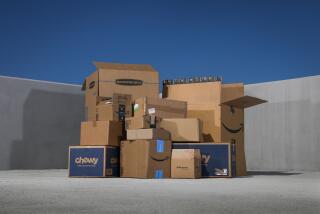Paper Firms Spend Millions to Find Perfect Package : Development: Many of the companies have elaborate research facilities as the industry shifts from the old “hatchet and saw” focus.
- Share via
NORCROSS, Ga. — Tom Santelli does terrible things to cardboard boxes.
Equipped with machines that would look at home in a horror movie torture chamber, researchers led by Santelli squeeze boxes, shake them silly and subject them to wild temperature changes.
All in search of the perfect package.
“We believe we can take any package challenge from our customers and meet their need,” said Santelli, director of Georgia-Pacific Corp.’s new package technology and development center.
Whether insulated cartons to ship McDonald’s hamburgers, brightly decorated 12-packs of Lone Star beer or heavy overnight envelopes for the U.S. Postal Service, a cardboard box these days serves as much more than a simple brown wrap-around.
Businesses are demanding packaging strong enough to protect their products, light enough to make shipping cheaper and made of recyclable material. With the popularity of warehouse-style stores that sell straight out of the carton, boxes sometimes even have to be portable billboards.
Aided by advances in computer technology, paper-making companies have invested millions of dollars in research laboratories. In fact, the companies have evolved over the last decade from “hatchet and saw” operations to manufacturing packaging, said William Cullison, executive director of the Technical Assn. for the Pulp and Paper Industry.
“Everyone has moved forward, and there are new applications of technology moving to the forefront. There are devices to measure the bumps and shakes in traveling from the warehouse to your house,” said Robert D. Leahy, spokesman for International Paper Co., which has a huge package innovation facility in Middletown, N.Y.
“It’s exciting for us because it’s a billion-dollar market,” Santelli said. “Everybody has to put their product in some kind of package.”
Georgia-Pacific, the big paper and forestry products company based in Atlanta, opened its $5.5-million center in June, consolidating research facilities that were split among several plants.
Here, boxes are designed on computer screens, which are connected to large cutting tables that automatically shape and perforate the cardboard.
To measure stacking strength, finished boxes are placed between a metal sandwich to be squeezed with up to 50,000 pounds of pressure while an electronic graph alerts a technician to the moment the cardboard buckles.
Strength also is tested at a bank of smaller machines, where one-inch cardboard squares are bent under watchful eyes.
These experiments end as soon as the sample begins to show damage. There’s no need to go all the way and pulverize a box, Santelli said.
“We stop when it starts to bend,” he said. “After that, it’s all downhill.”
More to Read
Inside the business of entertainment
The Wide Shot brings you news, analysis and insights on everything from streaming wars to production — and what it all means for the future.
You may occasionally receive promotional content from the Los Angeles Times.









